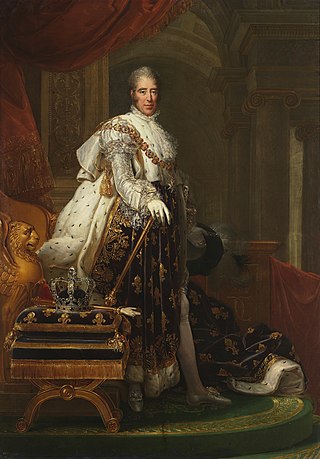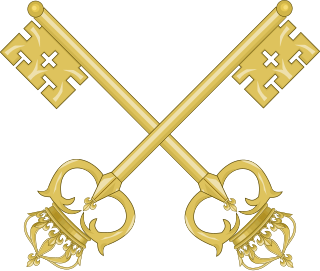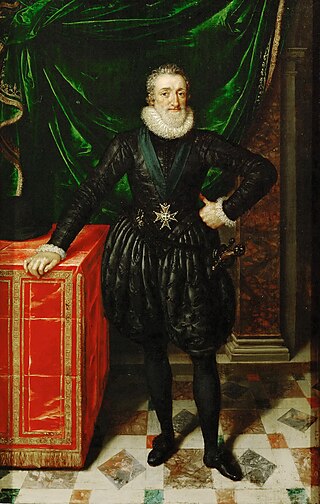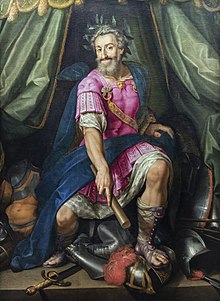Thoinot Arbeau is the anagrammatic pen name of French cleric Jehan Tabourot. Tabourot is most famous for his Orchésographie, a study of late sixteenth-century French Renaissance social dance. He was born in Dijon and died in Langres.

The House of Bourbon is a dynasty that originated in the Kingdom of France as a branch of the Capetian dynasty, the royal House of France. Bourbon kings first ruled France and Navarre in the 16th century. A branch descended from the French Bourbons came to rule Spain in the 18th century and is the current Spanish royal family. Further branches, descended from the Spanish Bourbons, held thrones in Naples, Sicily, and Parma. Today, Spain and Luxembourg have monarchs of the House of Bourbon. The royal Bourbons originated in 1272, when Robert, the youngest son of King Louis IX of France, married the heiress of the lordship of Bourbon. The house continued for three centuries as a cadet branch, serving as nobles under the direct Capetian and Valois kings.

Henry IV, also known by the epithets Good King Henry or Henry the Great, was King of Navarre from 1572 and King of France from 1589 to 1610. He was the first monarch of France from the House of Bourbon, a cadet branch of the Capetian dynasty. He pragmatically balanced the interests of the Catholic and Protestant parties in France as well as among the European states. He was assassinated in 1610 by a Catholic zealot, and was succeeded by his son Louis XIII.

Charles X was King of France from 16 September 1824 until 2 August 1830. An uncle of the uncrowned Louis XVII and younger brother of reigning kings Louis XVI and Louis XVIII, he supported the latter in exile. After the Bourbon Restoration in 1814, Charles became the leader of the ultra-royalists, a radical monarchist faction within the French court that affirmed absolute monarchy by divine right and opposed the constitutional monarchy concessions towards liberals and the guarantees of civil liberties granted by the Charter of 1814. Charles gained influence within the French court after the assassination of his son Charles Ferdinand, Duke of Berry, in 1820 and succeeded his brother Louis XVIII in 1824.

Louis Henri Joseph de Bourbon was the Prince of Condé from 1818 to his death. He was the brother-in-law of Philippe Égalité and nephew of Victoire de Rohan.
Ballet de cour is the name given to ballets performed in the 16th and 17th centuries at courts.
"Ding Dong Merrily on High" is a Christmas carol. The tune first appeared as a secular dance tune known under the title "Branle de l'Official" in Orchésographie, a dance book written by the French cleric, composer and writer Thoinot Arbeau, pen name of Jehan Tabourot (1519–1593). The words are by the English composer George Ratcliffe Woodward (1848–1934), and the carol was first published in 1924 in his The Cambridge Carol-Book: Being Fifty-two Songs for Christmas, Easter, And Other Seasons. Woodward took an interest in church bell ringing, which no doubt aided him in writing it. Woodward was the author of several carol books, including Songs of Syon and The Cowley Carol Book. The macaronic style is characteristic of Woodward's delight in archaic poetry. Charles Wood harmonised the tune when it was published with Woodward's text in The Cambridge Carol Book. More recently, Sir David Willcocks made an arrangement for the second book of Carols for Choirs.

The Grand Chamberlain of France was one of the Great Officers of the Crown of France, a member of the Maison du Roi, and one of the Great Offices of the Maison du Roi during the Ancien Régime. It is similar in name, but should not be confused with, the office of Grand Chamberman of France, although both positions could accurately be translated by the word chamberlain.
The precise style of French sovereigns varied over the years. Currently, there is no French sovereign; three distinct traditions exist, each claiming different forms of title.
The tourdion is a lively dance, similar in nature to the galliard, and popular from the mid-15th to the late-16th centuries, first in the Burgundian court and then all over the French kingdom. The dance was accompanied frequently by the basse danse, due to their contrasting tempi, and were danced alongside the pavane and galliard, and the allemande and courante, also in pairs.

Vallery is a commune in the Yonne department in Bourgogne-Franche-Comté in north-central France.
Bourbon-Vendôme refers to two branches of the House of Bourbon, the first of which became the senior legitimate line of the House of Bourbon in 1527, and succeeded to the throne of France in 1589 with Henry IV. He created the second house by granting the dukedom of Vendôme to one his legitimized sons.

Henry IV of France was the first Bourbon king of France. Formerly known as Henri of Navarre, he succeeded to the French throne with the extinction of House of Valois, at the death of Henry III of France.

The June Rebellion, or the Paris Uprising of 1832, was an anti-monarchist insurrection of Parisian republicans on 5 and 6 June 1832.

The Royal Chapel of Dreux situated in Dreux, France, is the traditional burial place of members of the House of Orléans. It is an important early building in the French adoption of Gothic Revival architecture, despite being topped by a dome. Starting in 1828, Alexandre Brogniart, director of the Sèvres porcelain manufactory, produced fired-enamel paintings on large panes of plate glass for King Louis-Philippe I, an important early French commission in Gothic Revival taste, preceded mainly by some Gothic features in a few jardins paysagers.
"Le Retour des Princes français à Paris" was the de facto national anthem of France during the Bourbon Restoration. It used the melody of the then popular marching tune Vive Henri IV.
The Canary dance was a Renaissance dance inspired in an indigenous dance and song of the Canary Islands that became popular all over Europe in the late 16th and early 17th century. It is mentioned in dance manuals from France and Italy, and is mentioned in sources from Spain and England, as well, including in plays by William Shakespeare.

One Nation, One King is a 2018 French film written and directed by Pierre Schoeller. It stars Adèle Haenel, Gaspard Ulliel, Laurent Lafitte and Louis Garrel, and shows the French Revolution in Paris from the storming of the Bastille to the execution of the King. The film made its world premiere out of competition at the 75th Venice International Film Festival on 7 September 2018. It was released in France by StudioCanal on 26 September 2018.
Events from the year 1593 in France










